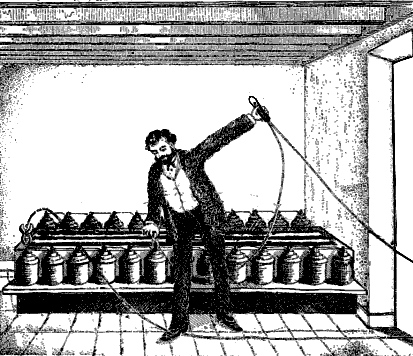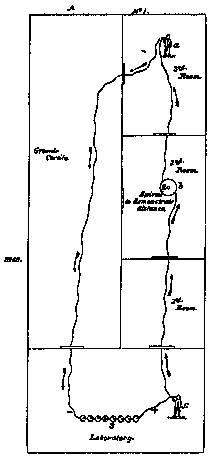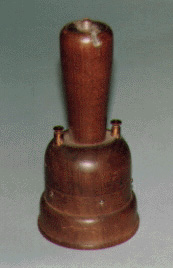 |
|
 |
|
|
|
|

Note 1.-- All information reported below is taken from the book by Basilio Catania "Antonio Meucci - L'inventore e il suo tempo" (Antonio Meucci - The Inventor and His Times).
Panel A0 This experiment was performed by Antonio Meucci around the end of 1849 in the premises adjacent to the left wall of the Tacón theater, where both the theater's workshop and the Meucci's apartment were located. The discovery of the transmission of the human voice by electricity was made while Meucci was applying electrotherapy to a patient suffering of rheumatisms in his head.
Panel A1: Physical layout of the experiment. Fig. 2 of Meucci's deposition(*), reproduced here below, shows the layout of Meucci's first experiment in Havana, performed in 1849. The first three rooms shown on top of the figure, were part of Meucci's apartment and were looking to the courtyard of the theater (shown at the bottom of the figure). The batteries (about sixty Bunsen batteries, yielding a total emf of about 114 volts) were located in the theater's workshop (shown at the right side of the figure), which communicated with Meucci's apartment through a door and also with the courtyard. The patient was located in the first room at the left of the figure, while Meucci was in the workshop. The big circle in the second room indicates a reel of wire.

(*) The deposition of Antonio Meucci, rendered Dec. 7, 1885 - Jan. 13, 1886, in the case "The American Bell Telephone Co. et al. vs. The Globe Telephone Co. et al.", is available in the New York Public Library (Annex), as well as in the National Archives and Records Administration, Northeast Region, New York, NY, under "Records of the US Circuit Court for the Southern District of New York".
Panel A2: Electrical layout of the experiment. Fig. 17 of Meucci's deposition, reproduced here below, shows more in detail the electrical layout of his first experiment. The patient was holding in his left hand the copper tongue of one of the instruments shown on top of the figure as "1", similar to the model shown in Window A1, without any cone added. Upon command received by Meucci, the patient put in his mouth the copper tongue of the other instrument, held in his right hand by its cork handle. Meucci could break the current to the patient either manually or through a suitable current breaker of his own design, indicated in the figure below, as "2". In his first experiment, he interrupted the current manually.
 |
1. insulated wooden tubes to be held in the hands, with a sponge on top communicating with the conductor to be applied to the sick part of the body
2. apparatus to break the current in giving the electric shoc
3. Series of Bunsen Batteries |
Panel A3: Meucci's posture during his first experiment. The figure below (taken from B. Catania's book, Vol. 1, p. 315), shows that Meucci, holding in his left hand an instrument similar to that of the patient, was bending down to switch on the current, by manually connecting one end of the wire to one end of the battery. At this moment, the patient yelled from the shock received. A sound reached Meucci's left ear, apparently coming from the instrument in his left hand. In his affidavit(*), Meucci stated: “I thought I heard this sound more distinctly than natural. I then put this copper of my instrument to my ear, and heard the sound of his voice through the wire. This was my first impression, and the origin of my idea of the transmission of the human voice by electricity.” These words can be thought as marking the beginning of the electrical transmission of the speech.

(*) Meucci's affidavit, sworn 9 October 1885, is included in his above-mentioned deposition.
Panel A4: Equivalent circuit of the experiment (see drawing below, by B. Catania). When the patient yelled, a strongly variable resistance Rv formed in his mouth between the copper tongue C2 and his saliva. This variable resistance, in turn, was connected, through his body, with the other copper tongue C1 in his left hand. The variable resistance Rv added to the total (fixed) resistance of the circuit Rw + Rb, where Rw was the resistance of the wire and Rb the internal resistance of the battery, thus making the total resistance Rv + Rw + Rb also variable. As a consequence of that, the electrical potential of Meucci's copper tongue C3 would vary accordingly, thus making the patient's yell audible to Meucci, by an electrostatic effect.

It may be remarked that Meucci, in this first experiment, exploited two quite advanced principles of telephone communication: the variable resistance principle, that was to be employed in either liquid or carbon "microphone" transmitters some 30 years later, and the variable capacitor principle, that was to be employed in the so-called "static telephone" at about the same time.
Window A1 displays a model reconstructed and donated by the Museo Storico PT of Rome, consistent with Figs. A and B of Meucci's affidavit, as reproduced here below. The model bears the following explanation:
Original Instrument Donated by the Museo Storico PT of Rome
Panel B0 Meucci's second experiment in Havana was performed shortly after his first one and was mainly aimed at preventing the patient from undergoing a strong electrical shock. This experiment (in fact, it was a series of like experiments) differed from the first one in three ways:
Panel B1 Fig. A of Meucci's affidavit, reproduced below, shows the layout of his second experiment. This figure is similar to that of Panel A1, though rotated by 90°, but it is now more evident that the patient "a" is not traversed by current. The outcome of this second experiment is described by Meucci in his affidavit as follows: “I directed him to speak … I being at the end of the third room, I placed my instrument, covered like his, to my ear. I then heard, while holding this to my ear, quite distinctly, the sound of his voice, so much so that I believed it came over the wire. I made him repeat what had said several times, which convinced me that I heard his voice over the wire electrically.”

Panel B2 The drawing below (by B. Catania) shows the equivalent circuit of this second experiment. Of course, no variable resistance in the patient's mouth existed any more; instead, the vibration impressed by the patient's voice upon his copper tongue only produced a variable capacitance C1 that caused similar vibrations to be induced in Meucci's copper tongue C2, as if the two copper tongues were the leaves of a (gold-) leaf electroscope, exploiting the same principle that would be employed, many years later, in the so-called "static telephone".

However, the speech transmission quality, featured by Meucci's second experiment, was not (and could not) be as good as that of his first experiment, basically because the powerful principle of variable resistance was not exploited. This is confirmed by Meucci himself in Answer No. 14 of his deposition: “At the moment that said individual spoke, I received the sound of the word; not distinct, but a murmur &emdash; an inarticulate sound. I caused it to be repeated several times in the same day, and then I tried it again in different days, and I obtained the same result. From this moment this was my imagination, and I recognized that I had obtained the transmission of the human word by means of conducting wire united with several batteries to produce electricity, and I gave it immediately the name of "Speaking Telegraph.”
His above words are a confirmation that Antonio Meucci considered his Havana's experiments as marking the discovery of the electrical transmission of the human voice.
Panel C1 In 1850 Meucci left Havana for the United States of America and went to live in Clifton (Staten Island), NY. In 1853, his wife, Esther, aggravated her rheumatoid arthritis to the point that she seldom could leave her bedroom, in the third floor of the house. Esther's illness stimulated the resuming of Meucci's speaking telegraph, as it would allow her to communicate with him and others from her bedroom. Therefore, between 1854 and 1855, Meucci established his first telephone link from Esther's room to the basement (where he had a small laboratory) and to a larger laboratory in the yard. To call attention, a traditional (mechanical) call bell was used, its wires running parallel to those of the telephone. Only one instrument was used at each end, that was alternatively brought to the ear or the mouth of the user. We reproduce below Fig. 12 of Meucci's deposition, showing the layout of his telephone links.

|
Panel C2
Meucci tried on the above said link very many kinds of telephones, steadily improving the quality of speech transmission with respect to that of his "static telephone" of 1849 in Havana. He came to satisfactory results around 1857, when he constructed an electromagnetic instrument (Fig. A at right, reproduced from "The Chicago Tribune" of 9 November 1885 ), in which he used a tempered steel bar "M", permanently magnetized, and a many-turns bobbin, both of which he bought from one Charles Chester, a manufacturer of telegraphic instruments in Centre St., New York. The diaphragm of this instrument was either made of a sheet of iron or of a stretched animal membrane bearing a small iron disk glued in the center. The air gap between the diaphragm and the bottom pole of the magnet could be adjusted by means of a screw. |
 |
Window C1 displays a model of Meucci's electromagnetic telephone of 1857, reconstructed and donated by the Museo delle Telecomunicazioni, SIRTI, of Cassina de' Pecchi (Milan), consistent with Fig. A here above. The model bears the following explanation:

Original Instrument Donated by the Museo delle Telecomunicazioni, SIRTI, Cassina de' Pecchi (Milan)
Window C2 displays a copy of page 3 of “The Chicago Tribune” of 9 November 1885 and bears the following inscription:
![]()
click here to see the original
paper
![]()